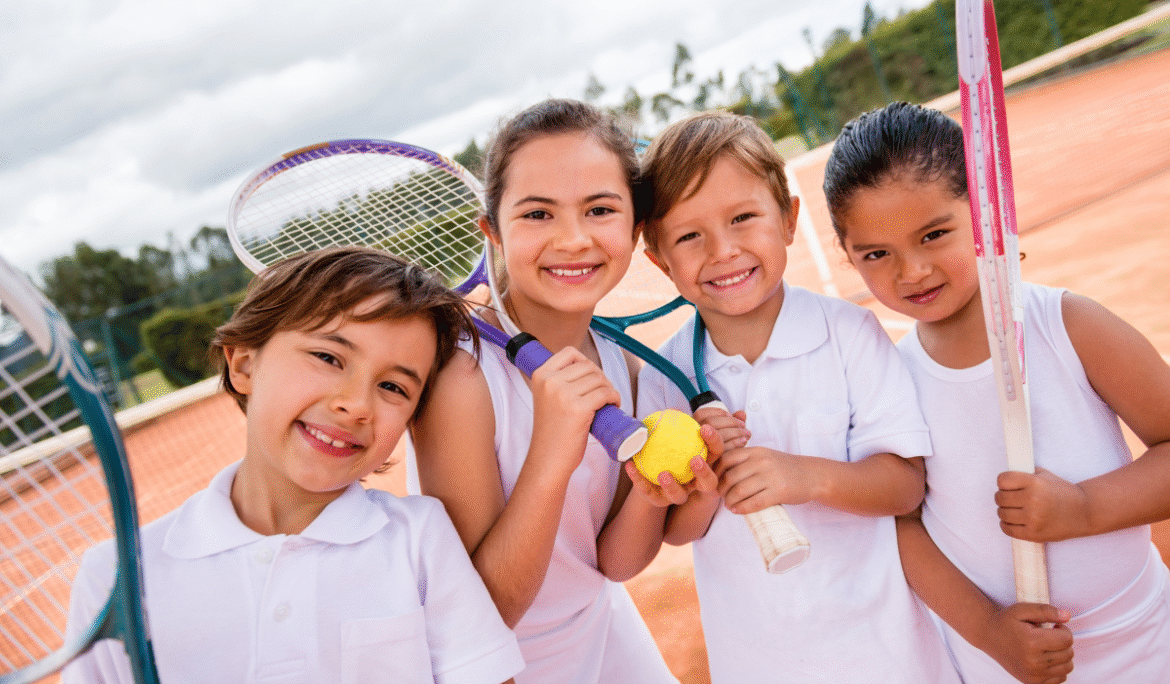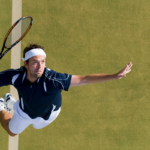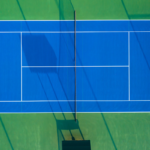Choosing the right kids’ tennis racket can feel overwhelming for parents. With so many sizes, weights, and materials available, how do you know which racket will help your child learn, play safely, and enjoy the sport?
At Infinity Racquet Club in Fulshear, TX, we’ve helped hundreds of families pick their child’s first (and second!) racket. Getting the right racket is critical—not just for performance, but also for injury prevention and building confidence on court.
In this guide, you’ll learn:
- How to select a kids’ tennis racket by age, height, and grip size
- Why weight and balance matter more than brand names
- Pro tips to avoid common mistakes parents make
- When to upgrade as your child improves
- Answers to frequently asked questions
Whether your child is just starting in our Future Champs program or already competing in junior tournaments, this guide will give you clear, practical advice.
Why Choosing the Right Kids’ Tennis Racket Matters
1. Safety First
An oversized or heavy racket can cause wrist and elbow strain. Using the correct size helps prevent injuries and allows kids to swing naturally.
2. Faster Skill Development
Kids learn faster when their equipment matches their body size. A racket that’s too big makes it harder to control strokes, while the right racket improves coordination.
3. Confidence on Court
Young players enjoy tennis more when they feel comfortable holding and swinging their racket. Confidence builds motivation to keep practicing.
Kids’ Tennis Racket Size Chart by Age & Height
The length of the racket is the most important factor. Junior rackets range from 19 inches to 26 inches, depending on age and height.
|
Child’s Age |
Height |
Recommended Racket Size |
Example Use |
|
3–4 years |
Under 40 in (1.02 m) |
19 in |
First tennis experience |
|
4–5 years |
40–44 in (1.02–1.12 m) |
21 in |
Beginner red-ball tennis |
|
6–8 years |
45–49 in (1.14–1.24 m) |
23 in |
Learning forehand/backhand |
|
8–10 years |
50–55 in (1.27–1.40 m) |
25 in |
Orange-ball programs |
|
10–12 years |
55–60 in (1.40–1.52 m) |
26 in |
Green-ball competition |
|
12+ years |
60 in+ (1.52 m+) |
27 in (adult racket) |
Transition to full court |
👉 At Infinity Racquet Club, our coaches always check racket size during junior tennis lessons. Parents are welcome to bring their child for a free 30-minute trial class to test different rackets.
Understanding Kids’ Tennis Racket Weight
Lightweight is Best for Beginners
- Range: 6–8 ounces (170–225 g) unstrung
- Kids should be able to swing the racket with one hand without struggling.
Balanced Weight Distribution
- Head-light rackets (more weight in the handle) give better control for younger kids.
- Head-heavy rackets offer more power but can feel harder to control for beginners.
Avoid Heavy Mistakes
A racket that feels “too big” or “too heavy” will make your child shorten their swing, preventing proper technique.
Grip Size: The Overlooked Factor
Grip size is measured by the circumference of the handle. Most junior rackets come in one standard grip size (3 ⅝ inches).
Quick Test: Ask your child to hold the racket. There should be a small gap (about a finger’s width) between their fingers and palm.
If the grip feels too big:
- Add an overgrip for comfort and cushioning.
If the grip is too small:
- Use a thicker replacement grip, but avoid starting with oversized handles.
Material & Strings: Do They Matter for Kids?
Frame Material
- Aluminum rackets: Affordable, lightweight, great for beginners.
- Graphite composite rackets: Slightly pricier but better for advanced juniors, offering more control.
Strings
- Most kids’ rackets come pre-strung.
- Focus less on string type at early stages; restringing becomes more important once your child competes in tournaments.
💡 Pro Tip: Infinity Racquet Club offers on-site stringing services, so upgrading strings as your child progresses is easy.
Tips for Parents Buying a Kids’ Tennis Racket
- Prioritize Fit Over Brand
Big names like Wilson, Head, or Babolat don’t matter if the racket is the wrong size. - Let Kids Try Before You Buy
During lessons, allow them to test different rackets. Coaches can quickly see which racket helps their strokes. - Upgrade Gradually
Don’t jump to a full-size adult racket too soon. Transition through the junior sizes to protect technique. - Consider Ball Type
Use the right training balls with the right racket size:
- Red foam balls → 19–21 in rackets
- Orange balls → 23–25 in rackets
- Green balls → 25–26 in rackets
- Check Balance & Comfort
If your child says “it feels heavy,” trust them. Comfort equals confidence.
When to Upgrade Your Child’s Racket
- Height Check: If the racket touches the ground when held straight down, it’s too long.
- Swing Speed: If your child struggles to complete a full swing, move to the next size.
- Coach Feedback: Our certified coaches often recommend upgrades when a child’s strokes and match play demand more control.
Common Mistakes Parents Make
- Buying Too Large Too Soon
Thinking they’ll “grow into it” only delays progress. - Ignoring Grip Size
Leads to poor hand positioning. - Overemphasis on Power
Technique matters more than racket strength for kids. - Skipping Professional Advice
Coaches know how racket size affects stroke mechanics.
Racket Recommendations by Age
Ages 3–5 (Red-Ball Stage)
- Racket: 19–21 in aluminum
- Example: Wilson US Open 19
- Focus: Fun, hand-eye coordination
Ages 6–8 (Orange-Ball Stage)
- Racket: 23 in
- Example: Babolat Nadal Junior 23
- Focus: Developing forehand and backhand consistency
Ages 9–11 (Green-Ball Stage)
- Racket: 25–26 in graphite composite
- Example: Head Radical Jr. 25
- Focus: Rallying and serving basics
Ages 12+ (Yellow-Ball Stage)
- Racket: 26 in or adult 27 in
- Example: Wilson Clash 26
- Focus: Tournament readiness and advanced footwork
How Infinity Racquet Club Helps Parents & Juniors
At Infinity Racquet Club, we don’t just sell lessons—we build tennis journeys.
- Free Trial Class: Every new junior gets a free 30-minute lesson to test rackets.
- Expert Guidance: Our coaches match kids with the right racket during junior programs.
- Flexible Memberships: Affordable family memberships let parents and siblings enjoy the club together.
- Events & Mixers: Kids gain experience through tournaments and community events.
👉 Want to see your child thrive in tennis? Contact us at 346-318-3556 or infinityracquetclub@gmail.com.
Frequently Asked Questions (FAQs)
1. What size tennis racket should a 7-year-old use?
A 23-inch racket is typically best for a 7-year-old, depending on height.
2. Can my child use my adult racket?
No. Adult rackets are too heavy and long, which can harm technique and cause injury.
3. How often should I replace my child’s racket?
Upgrade when they outgrow the size or when their coach recommends. On average, every 1–2 years.
4. Do strings make a big difference for kids?
Not at beginner level. For competitive juniors, restringing with proper tension helps performance.
5. Should kids play with aluminum or graphite rackets?
Aluminum is fine for beginners. Graphite is recommended as kids start competing.
Conclusion
Selecting the right kids’ tennis racket is more than a purchase—it’s an investment in your child’s enjoyment, safety, and progress in tennis. By focusing on size, weight, grip, and comfort, you set the foundation for success.
At Infinity Racquet Club, we help parents every day with these decisions. Whether your child is just starting or preparing for competition, our expert coaching, programs, and events create the perfect pathway.
📍 Visit us at 6215 Teal Rd, Fulshear, TX 77441 or explore our junior programs online.







